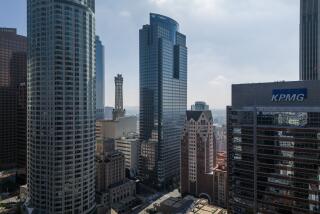L.A. council OKs Hollywood skyscrapers despite concerns over quake fault line
- Share via
The Los Angeles City Council approved a plan Wednesday that would radically alter the Hollywood skyline despite warnings from state officials that the project site may lie on a major earthquake fault line.
The 13-0 vote in favor of the Hollywood Millennium project allows New York-based developer Millennium Partners to build two skyscrapers and more than 1 million square feet of office, hotel and retail space on several vacant parking lots surrounding the iconic Capitol Records building. The towers would be 39 and 35 stories tall.
Mayor Eric Garcetti, who championed new development in Hollywood for 12 years on the City Council, said he planned to sign the deal. Newly elected Councilman Mitch O’Farrell, who replaced Garcetti after he termed out this year, called the $664-million project a “game changer” that would create jobs and new tax revenue while bringing more life to Hollywood’s eastern edge.
The council approved the project despite requests from opponents that the vote be delayed. Community members have complained that the skyscrapers are out of scale with the surrounding architecture and will add to already gridlocked traffic on neighboring streets and the busy 101 Freeway.
In recent days, they have also raised concerns about seismic safety, citing the project’s proximity to the Hollywood fault.
On Saturday, the head of the California Geological Survey, John Parrish, sent a letter to Council President Herb Wesson alerting him that the skyscrapers “may fall within an earthquake fault zone.”
Parrish said Wednesday that a map drawn by his agency in 2010 showed that the Hollywood fault “goes right through the Millennium site.”
He criticized a seismic report produced by the developer that said extensive testing showed that the building site was safe and did not lie on the fault line. Parrish said the report did not refer to his agency’s map and left out other important information.
The city’s Department of Building and Safety, which grants building permits, recently asked the developer to conduct additional seismic tests after an independent geologist contacted city officials with concerns about earthquake safety at the site.
Millennium co-founder Philip Aarons defended the company’s testing.
“Actual subsurface physical investigations are far superior to maps based on conjecture in locating faults,” he said.
He assured the council that his firm would work with the city and “is committed to safe, sound, responsible development.”
“It is not our interest to develop a project without addressing any and all seismic concerns,” he said.
Aarons described the skyscraper development as “foremost a preservation project” that would protect views of the Capitol Records building and the Hollywood sign. He noted that as part of a community benefits agreement, the firm has agreed to contribute seed money to create a park and put $4.8 million toward affordable housing in the area.
He said his firm hoped to break ground within the next year. But those plans could be disrupted if opponents sue.
Attorney Robert P. Silverstein, who represents a group of opponents called Communities United for Reasonable Development, said his clients have 30 days to decide whether to file a lawsuit.
Silverstein has sued to stop Hollywood developments many times before. He is now representing neighborhood groups in a lawsuit seeking to invalidate last year’s controversial Hollywood Community Plan, which changed zoning limits to allow bigger buildings in parts of the neighborhood.
He said that if the group does decide to legally challenge the Millennium project, it will probably make the argument that the developer failed to conduct an adequate environmental review, along with alleging other violations of law.
The project’s only vocal opponent at City Hall, Councilman Tom LaBonge, was not present at Wednesday’s meeting because of a death in his family.
In a statement, LaBonge said he would not have voted for the project if he had been present.
“I feel the height of the two towers is too tall and out of scale with the character of Hollywood,” LaBonge said.
He added that he was worried about the effect of traffic in the Hollywood Hills, an area that he represents.
More to Read
Sign up for Essential California
The most important California stories and recommendations in your inbox every morning.
You may occasionally receive promotional content from the Los Angeles Times.











